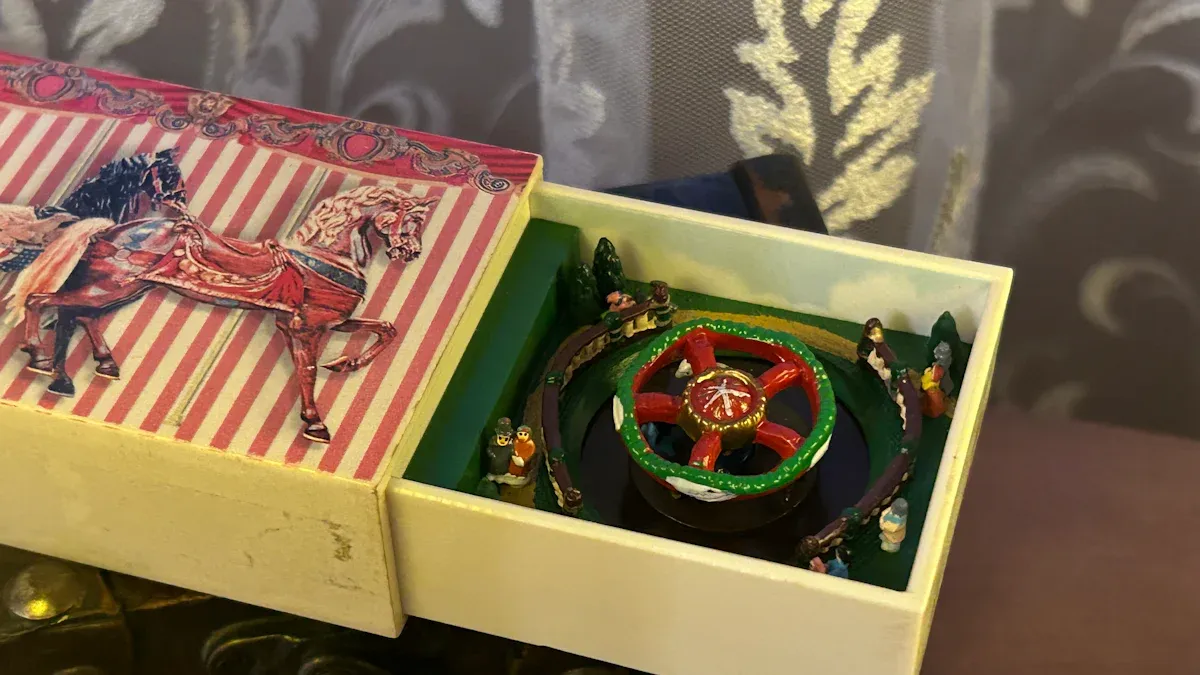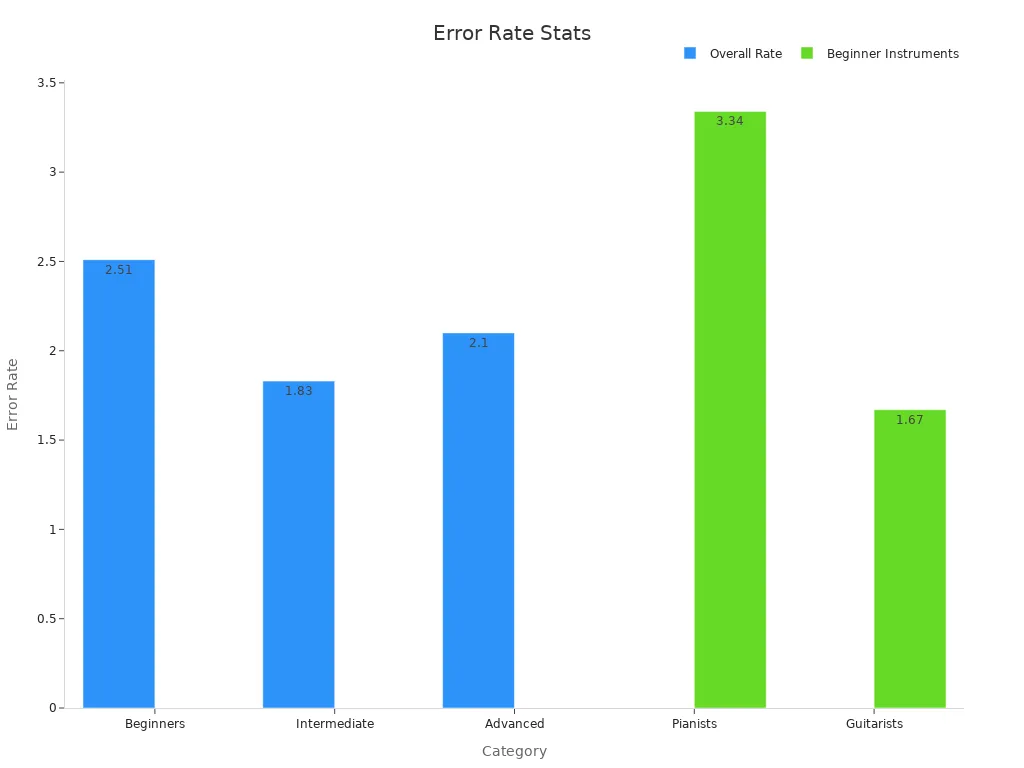Which Electric-Operated Musical Movement Should I Buy as a Beginner
The Sankyo Electric 18-Note electric-operated musical movement offers simple setup and clear sound. Many users who enjoy music box movements for crafts prefer this option over a spring-drived miniature musical movement. People who build custom music boxes or seek a custom 30 note music box often select this model for its reliability.
Key Takeaways
- Choose an electric-operated musical movement that is easy to use, reliable, and produces clear, pleasant sound to enjoy your musical projects.
- Compare models based on size, power source, sound quality, and price to find the best fit for your needs and budget.
- Always check compatibility, read reviews, and confirm warranty and support to avoid common beginner mistakes and ensure a smooth experience.
What Makes an Electric-Operated Musical Movement Beginner-Friendly?
Ease of Use
A beginner-friendly electric-operated musical movement should offer simple controls and intuitive operation. User testing highlights several measurable features that show ease of use:
- Move time and pitch selection accuracy help measure how quickly and correctly users can operate the device.
- Post-task questionnaires, such as the Single Ease-of-use Question (SEQ) and NASA Task Load Index (NASA-TLX), assess how easy and comfortable users feel during operation.
- Feedback types, like haptic or tactile feedback, influence how users perceive efficiency and dependability.
- Interviews and user experience surveys focus on learnability, feature controllability, and timing, which help beginners feel confident.
- Many users prefer haptic feedback, which increases awareness and enjoyment, making the device easier to use.
Reliability and Durability
A reliable electric-operated musical movement performs consistently over time. Manufacturers use quality materials to ensure the device withstands frequent use. Durable construction protects the internal parts from damage. Beginners benefit from a movement that does not require frequent repairs or adjustments. Consistent performance builds trust and encourages continued use.
Sound Quality
Sound quality matters for any musical device. A good electric-operated musical movement produces clear, pleasant tones. The notes should sound even and free from distortion. Beginners often appreciate a movement that delivers a rich, full sound without complex adjustments. High-quality sound enhances the overall experience and motivates users to keep practicing.
Price and Value
Affordability plays a key role for beginners. A beginner-friendly electric-operated musical movement offers good value for its price. It should include essential features without unnecessary extras that raise the cost. Buyers should compare prices and features to find the best option for their needs. A fair price ensures that beginners can start their musical journey without a large investment.
Top Recommended Electric-Operated Musical Movements for Beginners

Choosing the right electric-operated musical movement can help beginners start their musical journey with confidence. Below are three top models that stand out for their quality, ease of use, and value.
Sankyo Electric 18-Note: Pros and Cons
The Sankyo Electric 18-Note model remains a favorite among beginners. Many users appreciate its consistent performance and clear sound.
Pros:
- Simple installation process saves time for new users.
- Reliable motor ensures steady playback.
- Produces rich, pleasant tones that enhance any project.
- Compact size fits most music box designs.
Cons:
- Limited song selection compared to some competitors.
- Plastic casing may not feel as sturdy as metal options.
Tip: Beginners who want a dependable electric-operated musical movement often choose Sankyo for its balance of quality and price.
Yunsheng Electric 18-Note: Pros and Cons
Ningbo Yunsheng Musical Movement Manufacturing Co., Ltd. produces the Yunsheng Electric 18-Note. This model offers strong competition in the beginner market.
Pros:
- Durable construction withstands frequent use.
- Wide range of melodies available for customization.
- Smooth operation with minimal noise.
- Affordable price point makes it accessible for most beginners.
Cons:
- Slightly larger size may not fit all compact music box projects.
- Some users report minor variations in tempo.
| Feature | Sankyo Electric 18-Note | Yunsheng Electric 18-Note |
|---|---|---|
| Sound Quality | Clear, rich tones | Smooth, pleasant tones |
| Durability | Good | Excellent |
| Price | Moderate | Affordable |
| Song Selection | Limited | Wide variety |
Kikkerland Electric Music Box Module: Pros and Cons
The Kikkerland Electric Music Box Module appeals to beginners who want a modern design. This model offers unique features for creative projects.
Pros:
- Easy-to-use plug-and-play design.
- Lightweight and portable for craft projects.
- Compatible with many DIY music box kits.
Cons:
- Sound quality may not match traditional models.
- Fewer melody options available.
- Battery life can be shorter than plug-in models.
Note: Kikkerland’s module works well for simple projects but may not suit those seeking classic music box sound.
Beginners should compare these electric-operated musical movement options based on their needs and project requirements. Each model offers unique strengths that can help users create enjoyable musical experiences.
How to Choose the Right Electric-Operated Musical Movement
Intended Use and Application
Selecting the right electric-operated musical movement starts with understanding its intended use. Some users want a device for simple music box projects, while others need a movement for therapy or educational purposes. For example, in stroke rehabilitation, researchers used musical movements to sonify arm motions, capturing 3D spatial data and measuring improvements in movement smoothness. This application required precise feedback and reliable performance. In contrast, musicians and hobbyists often look for ease of use and versatility. Survey data show that people find general technology easier to use than specialized music-learning tools. Musicians also use technology differently depending on their goals, with career development and technical skills receiving more attention than presentation skills. By identifying the main purpose—whether for therapy, learning, or creative projects—users can choose a movement that matches their needs.
Size and Compatibility
Size and compatibility play a crucial role in the selection process. Each project may require a different movement size to fit within a specific enclosure or design. Users should measure the available space before purchasing. Compatibility with other components, such as power supplies or mounting hardware, ensures smooth integration. A table can help compare key size and compatibility factors:
| Feature | Importance Level | Notes |
|---|---|---|
| Physical Dimensions | High | Must fit inside the project enclosure |
| Mounting Options | Medium | Should match existing hardware |
| Connector Type | Medium | Needs to work with power source |
| Weight | Low | Important for portable projects |
Choosing the right size and ensuring compatibility prevents installation issues and supports long-term reliability.
Power Source Options
Power source options affect both convenience and performance. Some electric-operated musical movements use batteries, while others rely on plug-in adapters. Battery-powered models offer portability and flexibility, making them ideal for mobile or temporary setups. Plug-in models provide consistent power, which benefits projects that require long play times or frequent use. Users should consider the availability of power outlets and the expected duration of use. For example, a music box displayed in a living room may benefit from a plug-in model, while a portable craft project might need a battery-powered option. Checking the voltage and connector type also helps avoid compatibility problems.
Tip: Always check the power requirements before purchasing to ensure safe and reliable operation.
Customization Features
Modern electric-operated musical movements offer a wide range of customization features. Industry trends show a resurgence of retro sounds, modular synthesizer experimentation, and the blending of classic and modern production techniques. Users can find movements that support different genres, from synth-pop and house to EDM and hip-hop. Many devices now integrate with smart speakers and streaming services, allowing for personalized music playback. Voice-activated systems and AI-powered recommendations further enhance flexibility, adapting to user preferences and activities. Some movements even support real-time content adaptation, creating dynamic and engaging experiences.
- Electro music combines retro and modern sounds.
- Post-disco and rave music explore new textures and underground styles.
- Techno and synth-pop blend classic and contemporary elements.
- House and dubstep embrace cultural diversity and hybrid genres.
- Smart speakers and AI systems enable personalized playback and recommendations.
- Integration with home entertainment hubs increases user engagement.
These customization options allow users to tailor their musical experience, making each project unique and enjoyable.
Common Mistakes Beginners Should Avoid with Electric-Operated Musical Movements
Overlooking Compatibility
Many beginners forget to check if the musical movement fits their project. They may buy a device that does not match the size or power requirements of their music box. This mistake can lead to frustration and wasted money. Beginners should always measure their project space and review the product’s specifications. Checking compatibility with connectors and mounting hardware helps avoid installation problems.
| Factor/Condition | Beginners (Error Rate) | Intermediate (Error Rate) | Advanced (Error Rate) | Notes |
|---|---|---|---|---|
| Overall Error Rate | 2.51 (SE=0.16) | 1.83 (SE=0.17) | 2.10 (SE=0.17) | Beginners make significantly more errors than advanced and intermediate students. |
| Error Rate by Condition | Highest in first-sight (3.23), lowest in audio-motor (1.31). Beginners harmed most by lack of auditory feedback. | |||
| Most Frequent Error Types | Smoothness (2.67) | Smoothness errors dominate, followed by dynamics, note, and rhythm errors. | ||
| Instrument Differences | Pianists > Guitarists | Pianists make more errors, especially pitch, rhythm, and dynamics, due to instrument complexity. | ||
| Beginners’ Specific Errors | 3.34 (pianists), 1.67 (guitarists) | Beginners rely heavily on auditory feedback; lack of it increases errors. | ||
| Impact of Auditory Feedback | Significant | Beginners rely on auditory feedback for error correction; absence leads to more mistakes. | ||
| Training Importance | High | Long-term practice needed to form solid audio-motor associations; beginners lack this. |

Ignoring Sound Quality
Sound quality shapes the entire musical experience. Some beginners focus only on the melody or appearance and ignore how the device sounds. Studies show that tone quality depends on both sound and movement. Listeners can tell the difference between types of key touches, even when the volume stays the same. Reviews highlight that sound quality affects how people judge performance. In some cases, visual cues matter more, but in many musical settings, clear and pleasant sound stands out. Beginners should listen to samples and read reviews before making a choice.
Choosing Based on Price Alone
A low price can attract beginners, but it often means fewer features or lower quality. Many affordable models lack durability or produce weak sound. Beginners who choose only by price may end up replacing their device sooner. It is better to compare features, read user feedback, and consider long-term value. Spending a little more can lead to a better experience and fewer frustrations.
Tip: Always balance cost with quality and features to get the best results.
Forgetting About Warranty and Support
Warranty and customer support protect buyers from defects and problems. Beginners sometimes skip checking these details. If the device breaks or does not work as expected, a good warranty can save time and money. Reliable customer support helps answer questions and solve issues quickly. Always review the warranty terms and support options before buying.
Quick Buying Checklist for Electric-Operated Musical Movements

Define Your Needs
Buyers should start by identifying their main goals. Some want a music box for a craft project. Others need a device for therapy or education. The intended use shapes every other decision. Users should write down their top priorities, such as portability, sound quality, or ease of installation.
Compare Top Models
A side-by-side comparison helps buyers see differences in performance and features. Experts recommend using comparative analysis techniques. These methods match models with similar activity levels and musical output. For example, studies use music-feedback exercises to measure how different devices respond to movement and sound. Engineers also test structural changes, like new mounting designs, to improve sound quality. Comparing top models in this way reveals which options offer the best experience for each user.
Check Features and Specs
Shoppers should review product specifications before making a choice. Important features include the number of notes, available melodies, power source, and size. A simple table can help organize this information:
| Model Name | Notes | Power Source | Size (mm) | Melody Options |
|---|---|---|---|---|
| Model A | 18 | Battery | 60x45x30 | 5 |
| Model B | 18 | Plug-in | 65x50x32 | 10 |
Read Reviews and Ratings
Customer reviews provide real-world feedback. Ratings highlight strengths and weaknesses that may not appear in product descriptions. Users should look for comments about reliability, sound quality, and ease of use. High ratings often signal a dependable product.
Confirm Warranty and Return Policy
A good warranty protects against defects. Buyers should check the length of coverage and what it includes. A clear return policy makes exchanges or refunds easier if the product does not meet expectations.
Tip: Always keep receipts and warranty cards in a safe place for future reference.
The Sankyo Electric 18-Note stands out as the best choice for beginners. Careful research helps users select the right features. Starting a musical project becomes easier with the proper device. Anyone can enjoy making music by choosing a reliable electric-operated musical movement.
FAQ
What tools does a beginner need to install an electric-operated musical movement?
A beginner needs a small screwdriver, double-sided tape, and a compatible power source. Some kits include all necessary tools for easy installation.
Can users change the melody on an electric-operated musical movement?
Most models do not allow melody changes. Users should select a movement with their preferred song before purchase.
How long does the battery last in a typical electric-operated musical movement?
Battery life varies by model. On average, users can expect 8–12 hours of continuous play with standard batteries.
Tip: Always check the manufacturer’s specifications for exact battery life.